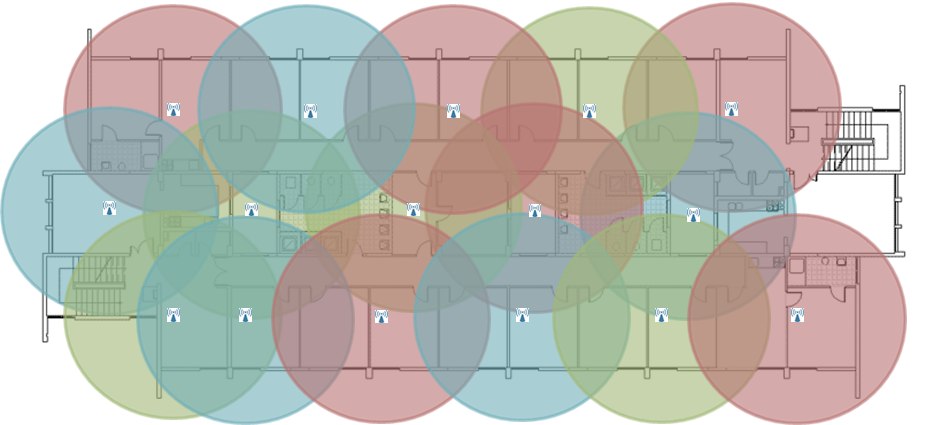This section provides solutions for three common use cases in an educational campus environment. Each use case includes simplified AP placement and channel plans.
Use Case 1 — Classroom
A classroom environment can be a challenging use case because of the combination of moderate to high client density, a relatively high per-client throughput requirement, and the close proximity of multiple classrooms. Video-based learning has become more prevalent, and this solution is optimized for a classroom video use case.
Requirements
- 30 client devices active concurrently in each classroom
- Tablets 802.11ac 1x1
- 4 Mbps throughput
Environment
- All DFS channels are available
- Interior walls have moderate attenuation
Channel Capacity Planning
For this use case, there are 30 tablets that are 802.11ac 1x1 active concurrently in each classroom. To support HD video, the throughput requirement for each client is 4 Mbps. In this example, DFS channels are available so we use an 80 MHz channel plan.
This channel capacity estimation is for a single classroom. The proposed solution can be scaled upwards to accommodate the total number of classrooms.
Step 1
Before you begin your calculations, you must know the estimated channel capacity per radio. You can find this information in Channel Capacity Estimates. When you reference the estimated channel capacity tables, an estimated clients per radio density is required. Because the classroom must support 30 concurrently active clients, this use case falls into the moderate density category,
|
Use Case |
Device Type |
Number of Active Devices / Density |
Application and Client |
Channel Capacity |
Per Device Airtime / Channel Capacity |
|---|---|---|---|---|---|
|
Classroom |
Tablets 11ac 1x1 |
30 / Moderate |
HD Video (720p) / |
139 Mbps/80 MHz |
2.88% |
The moderate density table in Channel Capacity Estimates shows that for 802.11ac 1x1 clients (1 Spatial Stream) with an 80 MHz channel, the estimated throughput capacity is 139 Mbps. To determine the percentage of airtime or channel utilization an individual client requires to meet a per-client throughput requirement, divide the throughput requirement by estimated channel capacity and multiply by 100.
- (App Bitrate or throughput / Channel Capacity) X 100 = Per Device Airtime
- (4 Mbps / 139 Mbps) x 100 = 2.88%
- Per Device Airtime = 2.88%
Step 2
You must now determine the total channels/radios required to deliver the throughput requirement to all clients simultaneously.
|
Use Case |
Device Type |
Number of Active Devices / Density |
Per Device Airtime |
Total Airtime |
Estimated Channels / Radios Required |
|---|---|---|---|---|---|
|
Classroom |
Tablets 11ac 1x1 |
30 / Moderate |
2.88 % |
86 % |
1 |
To estimate the total channels/radios required, multiply the per-client airtime required by the total number of clients active concurrently:
- Number of Active Devices x per Device Airtime = Channels/Radios Required
- 30 Active Devices x 2.88% per Device Airtime = 86.3%
- Channels/Radios Required = 1 (Rounding up)
Solution
This image shows the floor plan for a wing of the school building.
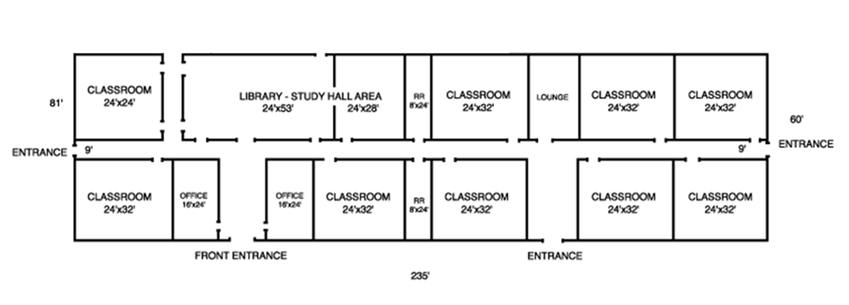
5 GHz Plan
This image shows the AP placement and 5 GHz channel plan for a wing of a school building. We recommend you use the AP420 for this use case. There are 12 ceiling-mounted AP420 devices for this wing of the building, each with an active 802.11ac radio (80 MHz).
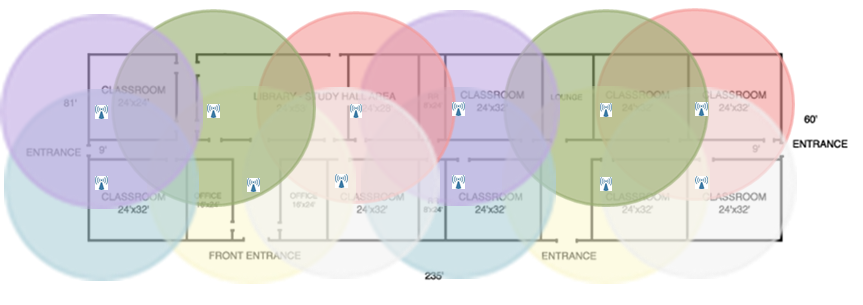
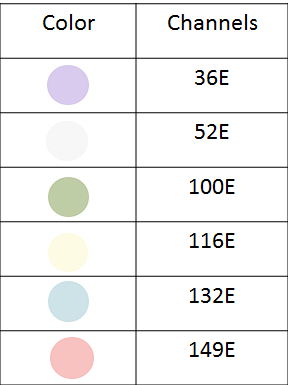
2.4 GHz Plan
This image shows the AP placement and 2.4 GHz channel plan for a wing of school building. While there are twelve AP420 devices used for this wing of the building, only seven of them have their 2.4 GHz radios enabled. Five of the 2.4 GHz radios are disabled to reduce the level of CCI in the 2.4 GHz band.
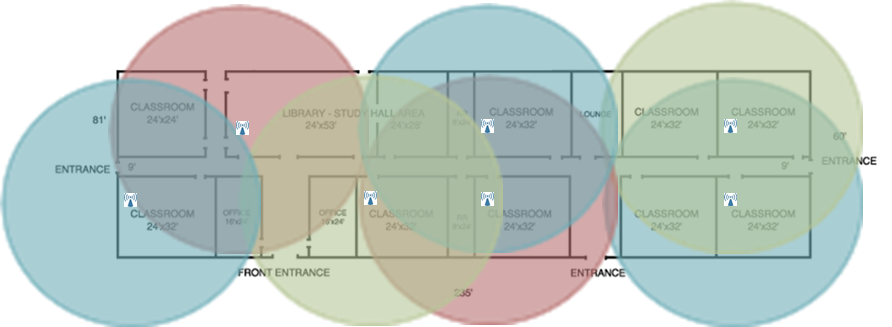
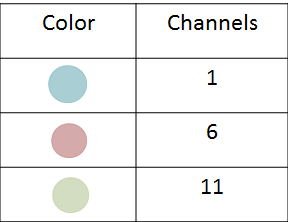
Use Case 2 — Lecture Hall
It can be a challenge to support a very high number of devices in a relatively confined space. These use cases are common in education environments. For this sample use case, at peak times there can be as many as 200 devices connected to the wireless network simultaneously.
For this use case, the device population is made up of an even mix of 802.11ac 1x1, 2x2 or 3x3 clients. The exact ratio of clients varies from day to day but for planning purposes, we recommend that you plan for 2x2 clients to simplify the process. If there were a larger proportion of 1x1 clients compared to 2x2 and 3x3, you would plan for 1x1 clients. Client fingerprinting capabilities in the current wireless network is the best way to determine a client mix for your use case.
Requirements
- 200 devices active concurrently in the lecture hall
- Mix of 802.11ac devices (1x1, 2x2, and 3x3)
- 3 Mbps throughput requirement
Environment
- All DFS channels excluding 100 are available
- All APs in the lecture hall are within line of sight of each other
Channel Capacity Planning
For this use case, there a mix of 200 802.11ac laptops, tablets, and smart phones that are active concurrently. The per client throughput requirement is 3 Mbps. All DFS channels are available, excluding 100 as the currently installed wireless network has detected radar activity on channel 100. We recommend an 80 MHz channel plan for this use case. If you use auto channel selection, then you must exclude channel 100 from the auto channel candidate list in the radio settings of the Device Template.
Step 1
The tables in Channel Capacity Estimates help determine the estimated channel capacity. The estimated per radio density for this use case is likely very high because the requirement is to accommodate 200 active clients in a confined area. The use of 2x2 clients in this plan simplifies the design process.
|
Use Case |
Device Type |
Number of Active Devices / Density |
App or Throughput requirement Bitrate |
Channel Capacity |
Per Device Airtime / Channel Capacity |
|---|---|---|---|---|---|
|
Lecture Hall |
Design for 11ac 2x2 |
200 / Very High |
3 Mbps |
173 Mbps/80 MHz |
1.73% |
The very high client density table in Channel Capacity Estimates shows that for 802.11ac 2x2 clients (2 Spatial Streams), with an 80 MHz channel, the estimated throughput capacity is 173 Mbps. To determine the percentage of airtime or channel utilization an individual client requires to meet a per client throughput requirement, divide the throughput requirement by estimated channel capacity and multiply by 100.
- (App Bitrate or throughput / Channel Capacity) X 100 = Per Device Airtime
- (3 Mbps / 173 Mbps) x 100 = 1.73%
- Per Device Airtime = 1.73%
Step 2
You must determine the total channels/radios required to deliver the throughput requirement to all clients simultaneously.
|
Use Case |
Device Type |
Number of Active Devices / Density |
Per Device Airtime |
Total Airtime |
Estimated Channels / Radios Required |
|---|---|---|---|---|---|
|
Lecture Hall |
Design for 11ac 2x2 |
200 |
1.73% |
347% |
4 |
To estimate the total channels/radios required, multiply the per client airtime required by the total number of clients active concurrently.
- Number of Active Devices x per Device Airtime = Channels/Radios Required
- 200 Active Devices x 1.73% per Device Airtime = 347%
- Channels/Radios Required = 4 (Rounding up)
Solution
This image shows the lecture hall floor plan.
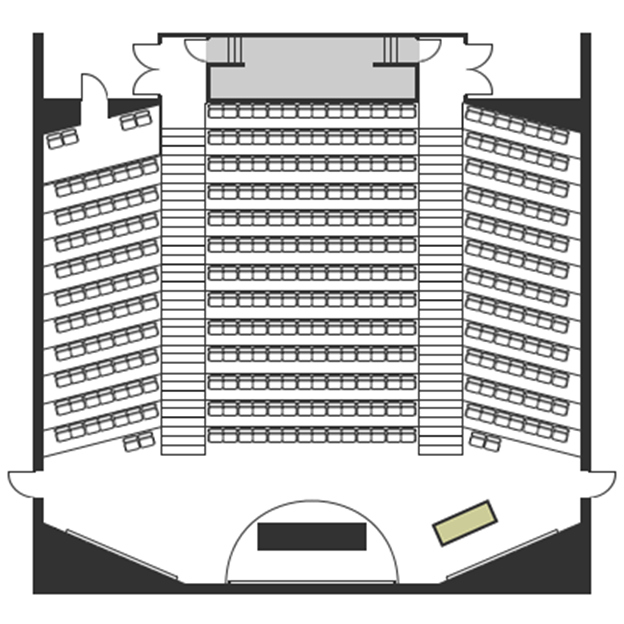
Auditorium Floor plan
5 GHz Plan
This image shows the AP placement and 5 GHz channel plan for the lecture hall. We recommend you use the AP420 for this use case. A total of four ceiling-mounted AP420 devices are used for the lecture hall, each with an active 802.11ac radio (80 MHz).
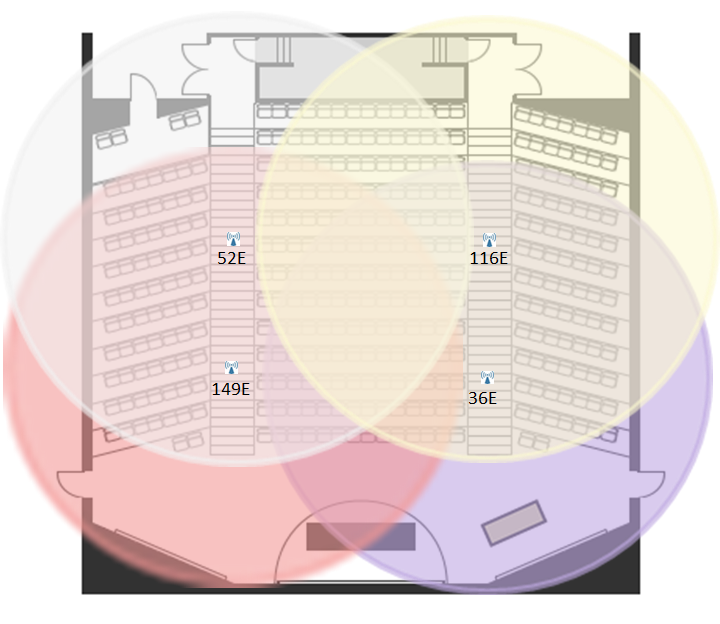
2.4 GHz Plan
This image shows the AP placement and 2.4 GHz channel plan for the lecture hall. While there are four AP420 devices used for the lecture hall, only three have their 2.4 GHz radios enabled. One of the 2.4 GHz radios is disabled to reduce the level of co-channel interference (CCI) in the 2.4 GHz band.
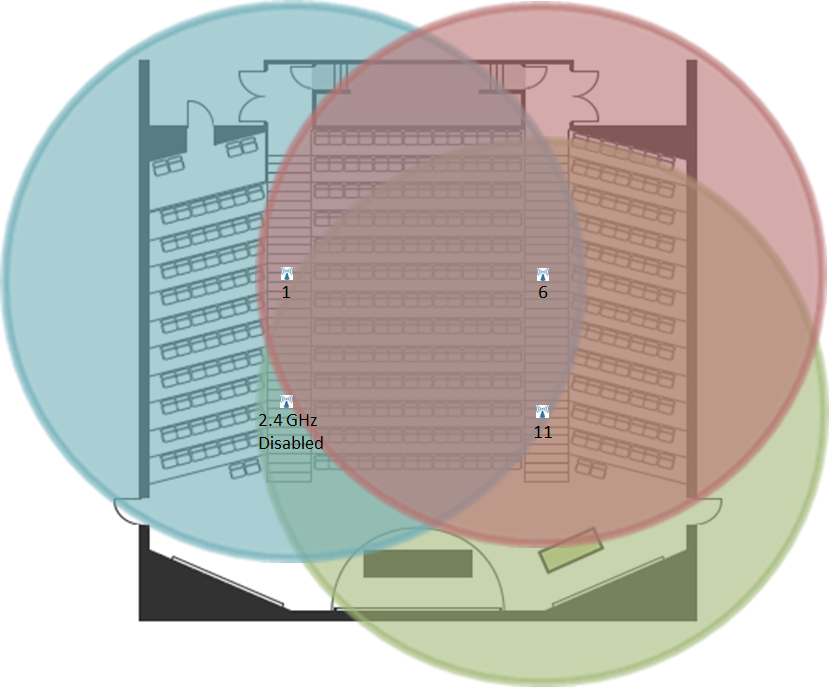
Use Case 3 — Dormitories
Students in dorm rooms depend on solid connectivity and performance to do homework, in addition to streaming movies and playing video games. Dorm room walls often have very high levels of RF attenuation. Install APs directly in the dorm rooms for a high signal strength (-62 dBm or greater) throughout the rooms.
Requirements
- 10 devices active concurrently in each dorm room
- Mix of 11n and 11ac devices (1x1, 2x2 and 3x3)
- 5 Mbps throughput requirement
Environment
- DFS channels are not available
- Dorm room walls have very high levels of attenuation
Channel Capacity Planning
For this use case there are 10 devices that are a mix of 802.11n and 802.11ac devices (1x1, 2x2 and 3x3), active concurrently in each dorm room. The requirement is to provide each client with a per client throughput requirement of 5 Mbps. DFS channels are not available so a 40 MHz channel plan is required.
This is a channel capacity estimation for a single dorm room. The proposed solution scales upwards to accommodate the total number of dorm rooms.
Step 1
For this use case the clients per radio density is low. Check the low client density table in Channel Capacity Estimates to get an estimated throughput capacity. For a mix of 802.11n and 802.11ac clients, we recommend a design for 802.11ac 1x1 or average clients.
|
Use Case |
Device Type |
Number of Active Devices/Density |
App or Throughput requirement Bitrate |
Channel Capacity |
Per Device Airtime / Channel Capacity |
|---|---|---|---|---|---|
|
Dorm Room |
Design for 11ac 1x1 |
10 / Low |
5 Mbps |
70 Mbps/40 MHz |
7.14% |
The low client density table in Channel Capacity Estimates shows for 802.11ac 1x1 clients (1 Spatial Stream) with a 40 MHz channel, the estimated throughput capacity is 70 Mbps. You must determine the percentage of airtime or channel utilization an individual client requires to meet a per client throughput requirement.
- (App Bitrate or Throughput requirement / Channel Capacity) X 100 = Per Device Airtime
- (5 Mbps / 70 Mbps) x 100 = 7.14%
- Per Device Airtime = 7.14%
Step 2
You must determine the total channels/radios required to deliver the throughput requirement to all clients simultaneously.
|
Use Case |
Device Type |
Number of Active Devices |
Per Device Airtime |
Total Airtime |
Estimated Channels / Radios Required |
|---|---|---|---|---|---|
|
Dorm Room |
Design for 11ac 1x1 |
10 |
7.14% |
71.4% |
1 |
To estimate the total channels/radios required, multiply the per client airtime required by the total number of clients active concurrently.
- Number of Active Devices x per Device Airtime = Channels/Radios Required
- 10 Active Devices x 7.14% per Device Airtime = 71.4%
- Channels/Radios Required = 1 (Rounding up)
Solution
This image shows the floor plan for a wing of the dormitory.

For this solution, you must deploy one AP per room because of the very high attenuation properties of the material used in the wall construction. For dorms with walls that have less attenuation, one AP per two rooms is preferable.
The proposed solution uses a 40 MHz channel. For a one AP per two room plan, you could use an 80 MHz plan to support the 5 Mbps per device throughput requirement. The number of devices per AP would double but so would the approximate throughput capacity of each AP.
We recommend you use an AP125, AP225W, or AP325 for this use case.
5 GHz Plan
This image shows the AP placement and 5 GHz channel plan for the dormitory with one AP per room. A total of 25 APs are used for the dormitory, each with an active 802.11ac radio (40 MHz).
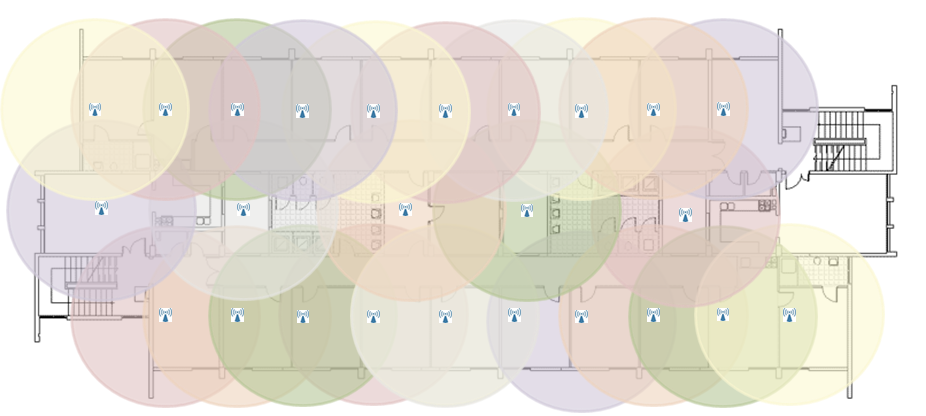
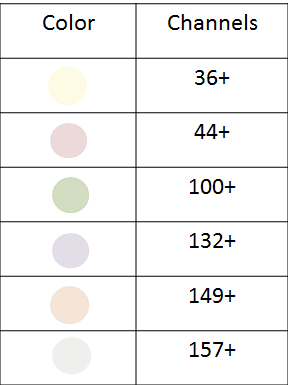
2.4 GHz Plan
This image shows the AP placement and 2.4 GHz channel plan for the dormitory. While there are 25 APs used for the dormitory, only 16 of them have their 2.4 GHz radios enabled. 2.4 GHz radios are disabled to reduce the level of co-channel interference (CCI) in the 2.4 GHz band.
